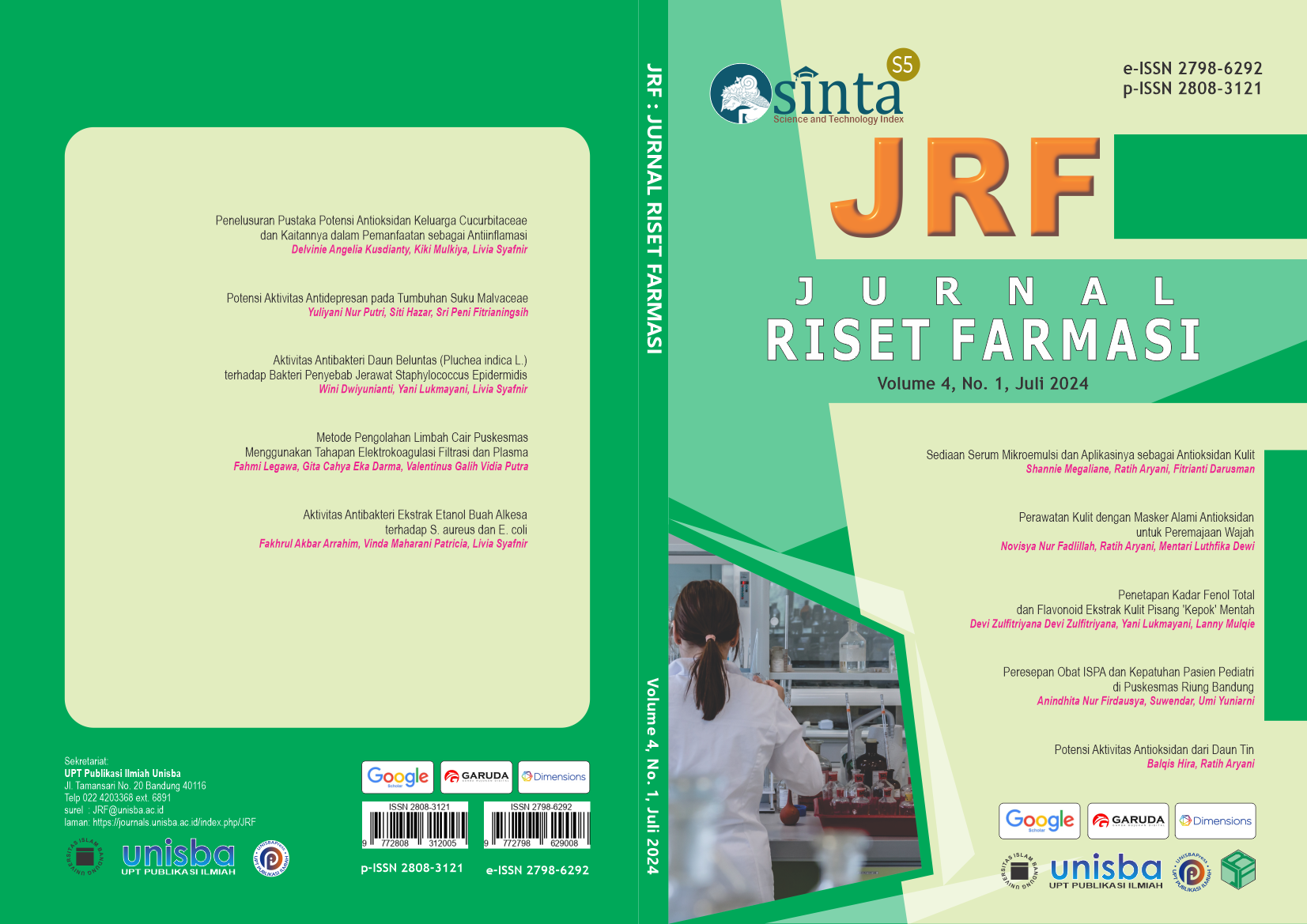Metode Pengolahan Limbah Cair Puskesmas Menggunakan Tahapan Elektrokoagulasi Filtrasi dan Plasma
DOI:
https://doi.org/10.29313/jrf.v4i1.3890Keywords:
Elektrokoagulasi, Filtrasi, PlasmaAbstract
Abstract. The high level of water pollution has become a serious problem in various regions, and health centers are one of the main sources of wastewater. Treating the liquid waste from health centers is crucial to reduce its negative impact on the environment and public health. This research aims to evaluate the influence of three treatment methods, namely electrocoagulation, filtration, and plasma, on the effluent quality standards. The results of the study show that the electrocoagulation process effectively reduces the values of BOD, COD, TSS, and pH in the health center's wastewater. Additionally, the filtration process proves to be effective in reducing BOD and COD values in the wastewater. Filtration successfully removes dissolved and bound organic matter in the wastewater, thereby decreasing the BOD and COD load in the treated water. Meanwhile, the plasma process also has a positive impact by reducing COD and pH values in the wastewater. The combined use of these methods is expected to meet the effluent quality standards set by environmental regulations and contribute to maintaining the environmental and public health. Treating health center wastewater with these methods proves to be an effective solution in reducing water pollution and safeguarding valuable water resources.
Abstrak. Tingginya tingkat pencemaran air menjadi masalah serius di berbagai daerah, dan puskesmas merupakan salah satu sumber utama limbah. Pengolahan limbah cair dari puskesmas menjadi penting untuk mengurangi dampak negatifnya pada lingkungan dan kesehatan masyarakat. Penelitian ini bertujuan untuk mengevaluasi pengaruh tiga tahapan metode pengolahan yaitu elektrokoagulasi, filtrasi, dan plasma terhadap standar baku mutu limbah cair. Hasil penelitian menunjukkan bahwa proses elektrokoagulasi dapat menurunkan nilai BOD, COD, TSS, dan pH dalam limbah cair puskesmas. Selanjutnya, proses filtrasi juga terbukti efektif dalam menurunkan nilai BOD dan COD dalam limbah cair. Filtrasi berhasil menyaring dan menghilangkan materi organik terlarut dan terikat dalam air limbah, sehingga mengurangi beban BOD dan COD dalam air limbah yang diolah. Sementara itu, proses plasma juga memberikan pengaruh positif dalam mengurangi nilai COD dan pH dalam limbah cair. Penggunaan kombinasi metode ini diharapkan dapat memenuhi standar baku mutu limbah cair yang ditetapkan oleh regulasi lingkungan dan berkontribusi pada menjaga kesehatan lingkungan dan masyarakat. Pengolahan limbah cair puskesmas dengan metode-metode ini menjadi solusi efektif untuk mengurangi pencemaran air dan melindungi sumber daya air yang berharga.
Kata Kunci: Elektrokoagulasi, Filtrasi, Plasma
References
D. Pratiwi and C. Maharani, “Pengelolaan Limbah Medis Padat Pada Puskesmas Kabupaten Pati,” J. Kesehat. Masy., vol. 9, no. 1, pp. 74–84, 2013.
S. Wulansari and R. Rukmini, “The Availability and Properness of The Health Care Facilities for Waste Handling Based on Indonesian Topography and Geo,” Bul. Penelit. Sist. Kesehat., vol. 19, no. 1, pp. 33–39, 2016, doi: 10.22435/hsr.v19i1.4987.33-39.
E. FATMALIA and R. D. A. SAPUTRA, “Studi Kualitas Air Limbah Puskesmas Di Kabupaten Lombok Utara, Provinsi Nusa Tenggara Barat,” Ganec Swara, vol. 15, no. 2, p. 1127, 2021, doi: 10.35327/gara.v15i2.227.
K. RI, Health Center Basic Data. Ministry of Health of the Republic of Indonesia. 2020.
K. RI, “PERATURAN MENTERI KESEHATAN REPUBLIK INDONESIA NOMOR 18 TAHUN 2020 TENTANG PENGELOLAAN LIMBAH MEDIS FASILITAS PELAYANAN KESEHATAN BERBASIS WILAYAH,” Energy Sustain. Dev. Demand, Supply, Convers. Manag., pp. 1–14, 2020.
E. Wardhani, M. Dirgawati, and K. P. Valyana, “Application of electrocoagulation method for leather tanning industrial waste water treatment,” 2012.
D. Ardiatma, A. Riyadi, and S. Setiawan, “Efektivitas Penurunan Kadar Tss, Cod, Bod, Dan Fosfat Menggunakan Metode Kombinasi Fitoremediasi Tanaman Kayu Apu Dengan Filtrasi Karbon Aktif Dan Silika Pada Air Limbah Domestik,” J. Teknol. Dan Pengelolaan Lingkungan, vol. 9, no. 1, 2022.
H. Amril, “Teknologi Plasma untuk Pengolahan Air,” no. June, pp. 0–8, 2016.
T. Agung and H. S. Winata, “Pengolahan Air Limbah Industri Tahu dengan Menggunakan Teknologi Plasma,” J. Imiah Tek. Kim., vol. 2, no. 2, pp. 19–28, 2011.
K. RI, Peraturan Menteri Kesehatan Republik Indonesia Nomor 129 Tahun 2008 Tentang Standar Minimal Pelayanan Rumah Sakit. 2008.
Shafa Savira Vaditya and Gita Cahya Eka Darma, “Pengaruh Penerapan Teknologi Plasma Pada Sheetmask Sebagai Peningkatan Penjerapan Essence,” J. Ris. Farm., pp. 65–68, 2023, doi: 10.29313/jrf.v3i2.3111.
N. A. Liestyoningrum, “Inventarisasi Limbah Cair Dan Padat Di Puskesmas Wilayah Surabaya Timur Sebagai Upaya Pengelolaan Lingkungan,” p. 145, 2015.
L. Samura, M. Maulani, C. Rosyidan, and V. G. V. Putra, “The Application of Non-Thermal Plasma and Electrocoagulation as Purifier of Liquid Waste in Home Industries,” JIPFRI (Jurnal Inov. Pendidik. Fis. dan Ris. Ilmiah), vol. 6, no. 1, pp. 24–31, 2022, doi: 10.30599/jipfri.v6i1.992.
B. Hari, “Pengolahan Libah Cair Tekstil Menggunakan Proses Elektrokoagulasi Dengan Sel Al-Al,” Jurnal Teknik, vol. 11. pp. 54–62, 2013.
M. W. Gameissa, Suprihatin, and N. Si. Indrasasti, “Advanced treatment of food industry wastewater by electrocoagulation using stainless steel electrodes,” E-jurnal Agroindustri Indoneisa, vol. 1, no. 1, pp. 31–37, 2012, [Online]. Available: http://tin.fateta.ipb.ac.id/journal/e-jaii
T. Hernaningsih, “Tinjauan Teknologi Pengolahan Air Limbah Industri dengan Proses Elektrokoagulasi,” J. JRL, vol. 9, no. 1, pp. 31–46, 2016.
D. Krismayasari and S. Sugito, “Aplikasi Teknologi Filtrasi Untuk Menghasilkan Air Bersih Dari Air Hasil Olahan Ipal Di Rumah Sakit Islam Surabaya,” WAKTU J. Tek. UNIPA, vol. 12, no. 1, pp. 17–23, 2014, doi: 10.36456/waktu.v12i1.817.
M. Sahruromdon, “Filtrasi CaCO3 Menggunakan Filter Plate & Frame Dengan Variasikonsentrasi Dan Variasi Jumlah Plate & Frame,” J. Tek. Kim. Univ. Sultan Ageng Tirtayasa, 2017.
A. W. Sukma, B. A. Seno, S. Nurjanah, and A. Syakur, “Peningkatan Kualitas Air Pantai Menjadi Air Bersih Dengan Penerapan Teknologi Plasma Non-Thermal Dan Multi-Step Filter,” DIPOIPTEKS J. Ilm. Mhs. Undip, vol. 1, no. 1, pp. 1–6, 2013.
G. C. E. Darma, “Mini Review : Farmasi Plasma,” J. Ilm. Farm. Farmasyifa, vol. 5, no. 1, pp. 20–32, 2022.












